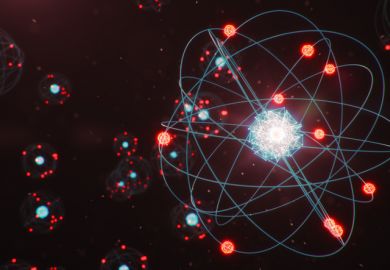Three quarters of a century ago, Arthur Stanley Eddington caught the imagination of the world with his dramatic telegram to The Times reporting a successful confirmation of Einstein's general theory of relativity. Eddington had been in charge of two teams of astronomers that in May 1919 had gone to distant parts of the world to observe an eclipse of the sun and had indeed found that light from distant stars is deflected as predicted by Einstein's theory as it passes the rim of the sun.
The report made Einstein into an international celebrity, while Eddington himself went on to write two very successful books, one popular and one technical, on the theory of relativity. During the two following decades, he wrote several more best-selling popular books. He possessed the fluency of Richard Dawkins, while his topics exerted the same sort of fascination with ultimate issues that draws modern readers to A Brief History of Time.
In addition, Eddington was a substantial scientist in his own right, having done brilliant pioneering work in astrophysics. His textbook The Internal Constitution of the Stars is an acknowledged classic. Eddington was the first scientist to fashion an essentially correct physical model of the stars. That was no mean achievement.
Yet, during the last decade and a half of his life, in which he attempted to come to terms with the seemingly contradictory theories of the newly discovered quantum mechanics and the somewhat older general relativity, Eddington wrote two books, Relativity Theory of Protons and Electrons (1936) and the posthumously published Fundamental Theory (he succumbed abruptly to cancer in November 1944), that have almost universally been condemned as bafflingly obscure or, where they can be understood, as patently wrong. When I studied mathematics in Cambridge at the end of the 1950s, we were warned to steer clear of the Fundamental Theory, that "graveyard of so many promising theoretical physicists".
Clive Kilmister, who retired some years ago after a successful career as professor of mathematics at King's College, London, makes no bones of the fact that half a century ago he "succumbed to the Eddingtonian magic" and that he has "kept returning to Eddington's work and puzzling over it". He grants the obscurity with which the ideas were presented "yet they continued to dazzle: flashes of insight grouped around a frame of numerical results." However, Kilmister's book is not primarily about the struggle to make sense of the flashes; he remarks that the time is now "passed in which I personally could hope to unravel the whole enigma."
It is a more modest attempt that is made here. In Kilmister's words: "How could it have come about that Eddington, such a lucid writer both professionally and in popular science, wrote two such obscure books at the end of his life? This book is an attempt to . . . answer that question. I found that it needed answers on many levels. The history of science, general history, Eddington's personal circumstances and his peculiar philosophy of science all had their part to play. I had to range over much of 20th-century physics and over Eddington's other work."
Kilmister has been totally successful in this aim. His book is a gem and does exactly what is promised. Kilmister writes with the lucidity of Eddington himself and with an admirable economy of words. It is, of course, a book intended for a relatively limited and sophisticated readership - as the blurb puts it, "scholars in the philosophy of science, theoretical physics, applied mathematics and the history of science" - but to that readership it cannot fail to give a lot of pleasure. The few but judiciously chosen extracts from Eddington's earlier books will remind the devotees, of which there are still a large number, what a marvellous writer he was, and there are also some splendid characterisations of Eddington himself. Particularly striking are quotations from Dingle's obituary, including: "In most matters the groove of his thinking was cut so deeply that only with difficulty, if at all, could the thoughts of others enter it", and "The inscrutable 'conditions of the world' hung like the Old Man of the Sea round the neck of his thought . . .". Kilmister's account of Eddington's "peculiar philosophy of science" is very well done (and persuaded this reader at least that Eddington's Kantian bent was a disaster), while the relatively sparse biographical details are invariably interesting. (Eddington was a Quaker and a stubborn conscientious objector; his appointment during the First World War to organise the famous eclipse expeditions was in part a device by his senior colleagues to remove him from the clutches of irate officialdom.) But there is also an important subplot to Eddington's Search for a Fundamental Theory, as the subtitle A Key to the Universe makes clear. The old Eddingtonian magic still has its grip on the author, and at least two chapters of the book, though ostensibly technical accounts of Eddington's ideas, are certainly also an apologia - for Eddington's attempt at a theory of the universe and for Kilmister's own attempts to understand it and rectify its defects. Here I feel Kilmister is not nearly so successful - or rather he is too successful: the scrupulously dispassionate account almost succeeds in making Eddington comprehensible, but I, at least, am left feeling that this strange amalgam of half-worked-out ideas, numerical concidences, and quirky philosophy cannot be anything but a graveyard into which we would probably never be tempted but for Eddington's status and the grandeur of his prose.
The problem, as Kilmister openly recognises, is the bridging of the gap from the purely algebraic point of departure to the kind of physical results Eddington hoped to achieve. The algebra of quaternions has four elements, three with square of one sign, one with square of the opposite sign. This fact could suggest to Eddington a deep connection between pure algebra and the (3 + 1) structure of spacetime. This train of thought leads on, under the stimulus of Dirac's publication in 1928 of the relativistic wave equation, to the Clifford algebra, which has 16 elements and most certainly does have a lot to do with spacetime structure, though the division of its elements according to the signs of their squares into ten and six elements does not seem to have much immediate significance. Eddington was then led to consider the product of two Clifford algebras, which has 256 elements, for which the division according to the signs of their squares gives 136 and 120. Now when Eddington got into this work in the late 1920s and early 1930s there was some possibility that the reciprocal of the so-called fine structure constant, which is an extremely important dimensionless number in physics and is a measure of the strength of elementary electric charges, might be exactly 136. Eddington clearly became obsessed with the idea that he had found a purely algebraic explanation of the fine-structure constant. Alas, experiment indicated within a few years that if the reciprocal of this constant was an integer, that integer must be 137. A few years later, and before Eddington's death, it had become quite clear that the value is definitely not an integer, though it is quite close to one (137.036 . . .). Nothing does more to damage a scientist's reputation than vain attempts to adjust a theory's predictions as more accurate experimental results come along. This happened to Eddington not once but twice.
Another difficulty, which for once Kilmister does not highlight, is that when Eddington started on his ill-fated investigations scientists believed the electron and proton to be the only elementary particles of nature. Eddington proceeded to construct a theoretical scheme that appears to rely heavily on this belief, though it was already proved false in 1932 with the discovery of the neutron. Indeed, a central part of his work revolved around the numerology of the proton-electron mass ratio, which he took to be about 1847, though it is now known to be 1836.11. Eddington tried to get this mass ratio from an enigmatic quadratic equation in which the "magic" numbers 10 and 136 from the Clifford algebra numerology appear as coefficients. What I miss in all Eddington's work that Kilmister reports is any sort of cogent physical argument that would explain why these purely algebraic numbers should lead to an explanation of the fine structure constant and the proton-electron mass ratio. The Clifford algebra is surely important in physics, but I fail to see any evidence of relevance to the actual numbers in which Eddington was interested.
However, even if Kilmister fails in his attempt to keep Eddington's theory alive, his book is a valuable addition to the literature.
Julian B. Barbour is the author of Absolute or Relative Motion? Cambridge University Press, 1989.
Eddington's Search for a Fundamental Theory:: A Key to the Universe
Author - C. W. Kilmister
ISBN - 0 521 37165
Publisher - Cambridge University Press
Price - £35.00
Pages - 256pp



